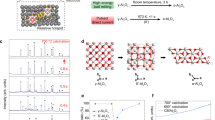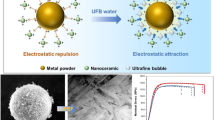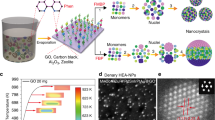Abstract
Nanometre-sized particles of transition (t)-aluminas are important for the fabrication of high-quality alumina ceramics. Multiple tons are produced each year using a variety of gas-phase processes1,2,3,4. The nanoparticles produced by these methods consist mainly of the undesired δ phase with some γ- and θ-Al2O3. Nano-t-aluminas should provide access to dense nano/submicrometre-grained α-Al2O3 shapes offering significant advantages over micrometre-grained shapes5,6,7,8,9,10,11. Unfortunately, polymorphism coupled with the high activation energy for nucleating α-Al2O3 greatly impedes efforts to process dense α-Al2O3 with controlled grain sizes, especially for submicrometre materials. Typically α-Al2O3 nucleation within t-aluminas is sporadic rather than uniform, leading to exaggerated grain growth and vermicular microstructures without full densification5. Thus, production of quantities of nano-α-Al2O3 from multiple nano-t-aluminas for seeding or direct processing of α-Al2O3 monoliths could greatly change how α-Al2O3 components are processed. We report here that liquid-feed flame spray pyrolysis3 of nano-t-aluminas converts them to dispersible 30–80 nm α-Al2O3 powders (50–85% phase transformed). Surprisingly, the powder surfaces are fully dehydrated. These powders pressureless sinter to more than 99.5% dense α-Al2O3 with final grain sizes ≤500 nm without sintering aids.
This is a preview of subscription content, access via your institution
Access options
Subscribe to this journal
Receive 12 print issues and online access
$259.00 per year
only $21.58 per issue
Buy this article
- Purchase on Springer Link
- Instant access to full article PDF
Prices may be subject to local taxes which are calculated during checkout



Similar content being viewed by others
References
Swihart, M. T. Vapor-phase synthesis of nanoparticles. Curr. Opin. Colloid Interface Sci. 8, 127–133 (2003).
Gutsch, A. et al. Gas phase production of nanoparticles. Kona 20, 24–37 (2002).
Hinklin, T. et al. Liquid-feed flame spray pyrolytic synthesis of nanoalumina powders. Chem. Mater. 16, 21–30 (2004).
Johnston, G. P., Muenchhausen, R., Smith, D. W., Fahrenholtz, W. & Foltyn, S. Reactive laser ablation synthesis of nanosize alumina powder. J. Am. Ceram. Soc. 75, 3293–3298 (1992).
Yarbrough, W. A. & Roy, R. Microstructural evolution in sintering of AlOOH gels. J. Mater. Res. 2, 494–515 (1987).
Parimal, J. P. et al. in Inorganic Optical Materials II (eds Marker, A. J. & Arthurs, E. G.) 1–14 (Proc. SPIE, Vol 4102, SPIE Optical Engineering Press, Bellingham, Washington, 2000).
Fischman, G. Validated microstructural assessment of femoral heads. J. ASTM Int. 1, 1–14 (2004).
Saikko, V. & Keränen, J. Wear simulation of alumina-on-alumina prosthetic hip joints using a multidirectional motion pin-on-disk device. J. Am. Ceram. Soc. 85, 2785–2791 (2002).
D'Antonio, J., Capello, W., Manley, M. & Bierbaum, B. New experience with alumina-on-alumina ceramic bearings for total hip arthroplasty. J. Arthroplasty 17, 390–398 (2002).
Krell, A. et al. Transparent sintered corundum with high hardness and strength. J. Am. Ceram. Soc. 86, 12–18 (2003).
Apetz, R. & van Bruggen, M. P. B. Transparent alumina; a light scattering model. J. Am. Ceram. Soc. 86, 480–486 (2003).
Bagwell, R. B., Messing, G. L. & Howell, P. R. The formation of alpha-Al2O3 from theta-Al2O3: The relevance of a ''critical size'' and: Diffusional nucleation or 'syncro-shear'? J. Mater. Sci. 36, 1833–1841 (2001).
Wen, H.-L. & Yen, F.-S. Growth characteristics of boehmite-derived ultrafine theta and alpha-alumina particles during phase transformation. J. Cryst. Growth 208, 696–708 (2000).
Echeberria, J., Tarazona, J., He, J. Y., Butler, T. & Castro, F. Sinter-HIP of α-alumina powders with sub-micron grain sizes. J. Eur. Ceram. Soc. 22, 1801–1809 (2002).
Hale, J. M., Aurox, A., Perotta, A. J. & Navrotsky, A. Surface energies and thermodynamic phase stability in nanocrystalline aluminas. Science 277, 788–791 (1997).
McHale, J. M., Navrotsky, A. & Perrotta, A. J. Surface energies and thermodynamic phase stability in nanocrystalline aluminas. J. Phys. Chem. B 101, 603–613 (1997).
Hongwei, M. & Krell, A. Synthesis and processing of nano-alpha-Al2O3 powders. Key Eng. Mater. 200, 43–46 (2002).
Azurdia, J. A. et al. Liquid-feed flame spray pyrolysis as a method of producing mixed-metal oxide nanopowders of potential interest as catalytic materials. Nanopowders along the NiO-Al2O3 tie line including (NiO)0.22(Al2O3)0.78, a new inverse spinel composition. Chem. Mater. 18, 731–739 (2006).
Laine, R. M., Marchal, J., Sun, H. P. & Pan, X. P. A new Y3Al5O12 phase produced by liquid-feed flame spray pyrolysis (LF-FSP). Adv. Mater. 17, 830–833 (2005).
Kimel, R. A. & Adair, J. H. Aqueous synthesis at 200 ∘C of sub-10 nanometer yttria tetragonally stabilized zirconia using a metal-ligand approach. J. Am. Ceram. Soc. 88, 1133–1138 (2005).
Godlinski, D., Kuntz, M. & Grathwohl, G. Transparent alumina with submicrometer grains by float packing and sintering. J. Am. Ceram. Soc. 85, 2449–2456 (2002).
Bowen, P., Carry, C., Luxembourg, D. & Hofmann, H. Colloidal processing and sintering of nanosized transition alumina. Powder Technol. (in the press).
Perez-Maqueda, L. A., Criado, J. M. & Real, C. Kinetics of the initial stage of sintering from shrinkage data: Simultaneous determination of activation energy and kinetic model from a single nonisothermal experiment. J. Am. Ceram. Soc. 85, 763–768 (2002).
Acknowledgements
This work was supported by the Air Force Office of Scientific Research on Contract F49620-03-1-0389. We thank G. Varga of Degussa and R. Brotzman of Nanophase for providing samples of nano-t-aluminas and M. Solomon and M. Kogan for help with the dynamic light scattering experiments.
Author information
Authors and Affiliations
Contributions
J.C.M. and R.M.L. were responsible for the experimental work, planning and the majority of the data analysis. X.P. and H.P. were responsible for the design and execution of weeks of extensive transmission electron microscopy work.
Corresponding author
Ethics declarations
Competing interests
The authors declare no competing financial interests.
Supplementary information
Supplementary Information
Supplementary figures S1 and S2 (PDF 2466 kb)
Rights and permissions
About this article
Cite this article
Laine, R., Marchal, J., Sun, H. et al. Nano-α-Al2O3 by liquid-feed flame spray pyrolysis. Nature Mater 5, 710–712 (2006). https://doi.org/10.1038/nmat1711
Received:
Accepted:
Published:
Issue Date:
DOI: https://doi.org/10.1038/nmat1711
This article is cited by
-
High-surface-area corundum nanoparticles by resistive hotspot-induced phase transformation
Nature Communications (2022)
-
Synthesis of Functional Oxide Nanoparticles Through RF Thermal Plasma Processing
Plasma Chemistry and Plasma Processing (2017)
-
Disperse fine equiaxed alpha alumina nanoparticles with narrow size distribution synthesised by selective corrosion and coagulation separation
Scientific Reports (2015)
-
Effect of SPPS Process Parameters on In-Flight Particle Generation and Splat Formation to Achieve Pure α-Al2O3 Coatings
Journal of Thermal Spray Technology (2015)
-
Hybrid Processing with Powders and Solutions: A Novel Approach to Deposit Composite Coatings
Journal of Thermal Spray Technology (2015)



